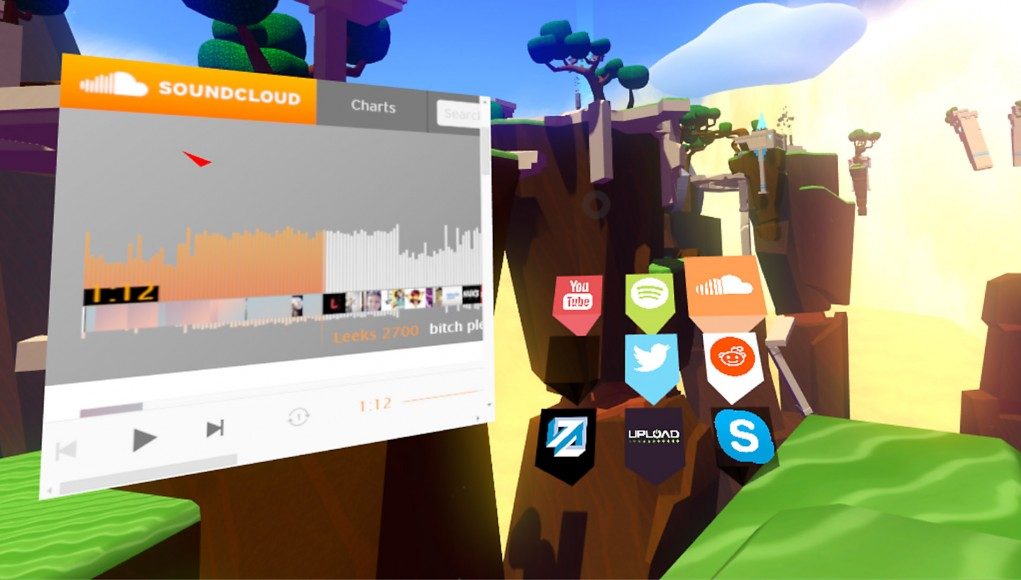In the real world, most of us have a smartphone in our pocket which means we’re just a few taps away from a wealth of apps and services that enable us to do all manner of things, from communicating with friends, to listening to music, to referencing the vast library of knowledge that exists on the web. Ironically, when we put on a VR headset and become more intimately connected with the digital realm than ever, we actually lose access to many of those functions that we’re used to having simply because we can’t use our smartphones while in VR.
V (yes, just the letter “V”) aims to solve this problem in an elegant way. The application functions as a sort of universal dashboard which serves to pipe the power of the web into any VR application. The premise is deliciously simple: with an incredible wealth of useful mobile web apps designed with simple, touch-friendly interfaces, why not use these as widgets while inside virtual reality, connecting the user to their existing digital lives in one fell swoop?
If I’m playing a flat desktop game, it’s easy enough to glance over at my smartphone on the desk. If I’m playing in VR however, I’m effectively in a bubble; I can’t check my email, see social media notifications, or even look up a video guide for the game that I’m playing. If we’re going to be spending lots of time in VR, this is a problem.
For instance, I myself am a big SoundCloud user and love to listen to music while I play and work. For a VR game like Elite Dangerous, which has me spending significant amounts of time traversing the vastness of interstellar space, being able to browse and change my music on SoundCloud, from inside my ship, would be huge. Not to mention keeping an eye on Twitter notifications and Facebook messages during my multi-hour session as the pilot of an interstellar craft.
[gfycat data_id=”BoilingRealisticDromedary” data_autoplay=true data_controls=false]
And that’s exactly what V does by leveraging the wealth of mobile web apps that are already out there and work great as widgetized versions of the web services that we already use every day. With the press of a button, I can pull up the V dashboard to access Youtube or Tumblr—hell, I could even check out the latest articles on Road to VR if I wanted to!
V achieves this in an enviously smart way that doesn’t require per-game integration by developers. Instead, the V dashboard is injected directly into the render pipeline, allowing it to pop up as an overlay inside any VR game that’s built using a supported engine. To start, the creators are aiming to support Unreal Engine and Unity, with which the vast majority of VR games today are built.
[gfycat data_id=”ScientificVibrantAlaskankleekai” data_autoplay=true data_controls=false]
It may seem simple, but their injection method could be key to the system’s success: not only does V leverage a massive library of existing websites and web apps, it pipes them effortlessly into VR without any need to sell developers on the idea, giving the app a true shot at becoming a universal dashboard across any VR application.
At SVVR 2016 last week, founders Tyler Andersen and Brian Eppert showed me a functional prototype of the V dashboard which could be called up inside of Colosse, a Unity-based Oculus Rift experience which the company says they didn’t modify in any way.
On the dashboard was a series of icons representing web apps like Twitter, Facebook, Reddit, SoundCloud, Spotify, YouTube, and more. Clicking on them would launch a smartphone-sized browser window with the apps inside working just as you’d expect them to. Beyond just staying connected to your digital world while in VR, there’s clear use-cases where V can even add to the VR experience, like being able to pin a reference photo into the environment while making VR paintings in Tilt Brush, or watching a video guide showing where all the secret coins are in Luckey’s Tale.
And even all of that might just be the tip of the iceberg for V. When you consider that WebVR could be used to make VR-aware web apps, the long-term potential of V becomes even more enticing.
Andersen and Eppert recently graduated from the Boost VC accelerator and say that they’re actively fundraising. The duo plans to launch a private beta with support for the Oculus Rift in June and aim to later support the HTC Vive / SteamVR as well. You can sign up for the private beta on the V website.







